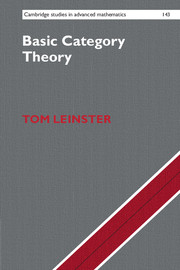Book contents
3 - Interlude on sets
Published online by Cambridge University Press: 05 August 2014
Summary
Sets and functions are ubiquitous in mathematics. You might have the impression that they are most strongly connected with the pure end of the subject, but this is an illusion: think of probability density functions in statistics, data sets in experimental science, planetary motion in astronomy, or flow in fluid dynamics.
Category theory is often used to shed light on common constructions and patterns in mathematics. If we hope to do this in an advanced context, we must begin by settling the basic notions of set and function. That is the purpose of the first section of this chapter.
The definition of category mentions a ‘collection’ of objects and ‘collections’ of maps. We will see in the second section that some collections are too big to be sets, which leads to a distinction between ‘small’ and ‘large’ collections. This distinction will be needed later, most prominently for the adjoint functor theorems (Chapter 6).
The final section takes a historical look at set theory. It also explains why the approach to sets taken in this chapter is more relevant to most of mathematics than the traditional approach is. None of this section is logically necessary for anything that follows, but it may provide useful perspective.
I do not assume that you have encountered axiomatic set theory of any kind.
- Type
- Chapter
- Information
- Basic Category Theory , pp. 65 - 82Publisher: Cambridge University PressPrint publication year: 2014



